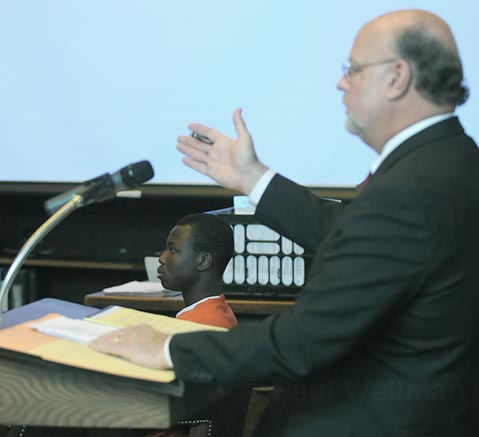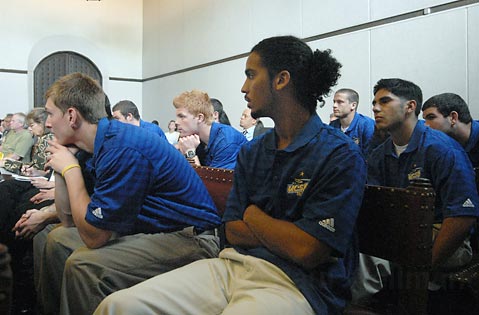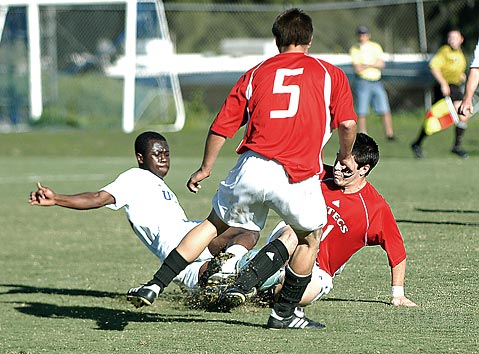Frimpong Case: Eric on Trial
Chapter Nine of Joel Engel's Eric Frimpong Investigation

Read the previous chapter here.
The trial of Eric Frimpong began in late November. Soon to be 22, he had never been in trouble with the law, had just earned his bachelor’s degree in a difficult dual major for which jobs were plentiful around the world, and quite likely would be tendered a contract to play Major League Soccer. By all accounts he was friendly and well liked, and, owing if nothing else to his celebrity as a star of the championship soccer team, could have had his pick of admiring young women. No one in his family or tribe ever had so much going for him. But of course, gifted and intelligent people often commit evil, so put that aside.
How likely is it, though, that an intelligent young man would meet a young woman in a public place, walk 300 yards down a crowded street with her, introduce her to each of his roommates, lead her to a spot on the beach where anyone can happen on or hear them, including the homeless who live there, then rape her, bite her face and buttock, then attend a party, sleep beside his girlfriend, awaken in the morning and not wash off the presumably abundant DNA left on his penis, spend the morning playing ping pong in daylight beside the house where all this allegedly happened before – and cap off a whirlwind 12 hours by volunteering to give police his own DNA before allowing his genitals to be swabbed for genetic residue and offering the clothing he wore as evidence?
Not very likely, one would think.
Actually, Eric was facing two counts, the second instigated by another freshman student named Morgan Menzies, who after seeing the Daily Nexus story about Eric’s arrest (which included all the allegations of what happened on the beach) drove to the sheriff’s station and alleged that, a month before, he had committed sexual battery against her. She said she’d met Eric, heard he was a soccer player, and challenged him to a race on the beach. Once there, she claimed, he tried to grab at her and wouldn’t stop, even tackling her – at which point she ran back up the beach access, leaving her purse and phone behind.
Eric tells a completely different story. The record shows that he called a number in her phone immediately after she left, trying to return both it and the purse to her before leaving for Kansas City to meet with the soccer team that had drafted him.
“Hey, sorry I ran away,” Menzies wrote Eric on Facebook, knowing that he’d attempted to reach her. “I was pretty drunk last night. Thanks for grabbing my stuff! How can I get it back?”
Eric responded: “actually training with Kansas City Wizards in Kansas and I will be back on Tuesday, sorry for inconvenience.” To which she replied, “just let me know when I can come get it on Tuesday.” But a few days later, she wrote to someone else: “I hate that guy eric frimpong! He can suck it ‘cuz I want my damn phone. Once I get it back, I’m gonna be such a bitch to him.”
When he returned, she did get her phone and purse back, and Mary Barron seized on her story to file another count that allowed her to convey implicitly the sense that her defendant was a career predator.
Eric was acquitted on count two, and despite the sheriff’s deputies’ and Barron’s best efforts, it does seem reasonable to conclude that he would have been acquitted of Jane Doe’s rape, too, if Robert Sanger had crafted a more cohesive story for the jury. For example, despite the many questions about Benjamin Randall, one juror told us that his name barely came up during deliberations.

Sanger might also, it appears, have been better prepared. One small but telling opportunity was missed when Barron questioned Joel Rivlin, the deputy whose report claimed that Justin Hannah had seen sand on Doe. Rivlin testified that, “at the time of the assault,” the tide was “just about at its lowest” – meaning that the beach between Embarcadero and Pescadero would have been passable for Doe; and that when he got to the Pescadero stairs to fetch Doe’s purse and shoes from the beach, “the tide at this point was coming up with the waves coming all the way to the cliff [sic].” This prevented him from going down to the beach, where the items had presumably been carried away by the surf. (If the purse and shoes were at the other end of the beach, they would have been untouched by that morning’s tide, yet they never turned up.)
As with the sand, Sanger did not challenge Rivlin to substantiate his statement about low tide occurring “at the time of the assault.” If he had objected on the grounds that the detective had no basis in fact for his testimony, Barron would have been forced to enter into evidence the tide charts sitting in the discovery files. But that would have made Rivlin look foolish or worse – like a liar.
In fact, the chart someone had apparently downloaded from the Internet (not certified by the National Oceanic and Atmospheric Association) shows that low tide occurred just before 3 a.m. – not at 12:30 or one a.m., as Rivlin had testified. Which is why Barron might have let Sanger’s objection stand, an inference made reasonable by her having not entered the chart as an exhibit before asking her witness the question. The tide Rivlin observed lapping the cliffs was still two hours from its high of the morning, and only about two feet higher than it had been at the time of the alleged assault. This suggests that Doe’s feet, if not her jeans, would have been soaked and sandy from where the stairs met the beach – another issue that Sanger didn’t raise.
He also missed shocking the jury with a dramatic Johnny Cochran kind of moment. When Detective Scherbarth testified that he found sand in the cuffs of Eric’s jeans, Sanger could have given the pants to Eric to try on the way O.J. Simpson put the bloody glove on his hand as proof that it didn’t fit. Cuffed, the pants would have come up to Eric’s ankles, leaving Barron to argue that, well, maybe Eric had turned the cuffs up on his jeans before walking on the beach : to rape Doe : before going to a party and then his girlfriend’s, where he slept atop the covers in those same jeans, and left no sand in the bed.
That, of course, would have been a ludicrous story – but no less believable than Doe’s alleged walk on the beach, or the way Department of Justice criminalist Lillian Tugado tried to account for the awkward fact of Randall’s DNA winding up in Doe’s panties.

There was much to account for. Doe’s testimony that she’d gone out that night in clean panties conflicted with Randall’s insistence that he’d used a condom for their last sexual encounter. Tugado explained the clean panties by noting that the lack of an enzyme called acid phosphate in the semen sample indicated that the stain had survived a wash. But she’d also theorized that Randall’s semen might have hidden in Doe’s body several days before staining her panties that night. As with Doe’s and Randall’s statements, Tugado’s two theories were mutually exclusive. Was the semen hiding or not there at all? And if it was hiding, how did it escape the condom?
By trial’s end, Barron still hadn’t explained the complete absence of Eric’s DNA on Doe – no ejaculate, no perspiration, no saliva, no hair – an inconvenient fact that left her to claim in her closing argument: “You also heard from Nurse Malmgren that most of the times [sic] in sexual assault cases there’s not ejaculation.” But the jury had heard no such thing. This was a blatant distortion of Malmgren’s simple yes answer to Barron’s question whether she “often” sees cases of rapists not ejaculating.
The prosecutor’s most compelling evidence against Eric were, in the words of the report by senior criminalist Dianne Burns, “a few cells” of Doe’s DNA found on Eric, including one on his fingertip. This would have been overcome by Eric’s taking the stand to explain in detail – and without being interrupted – the story he tried to tell Kies and did tell Detectives Scherbarth and Ruth. Not putting a defendant on the stand is a perfectly acceptable defense tactic, and some lawyers never put their clients on. But in the post O.J. Simpson world, juries need an explanation for DNA evidence, and Sanger did not offer this jury a qualified expert to hammer home the findings that Doe’s DNA had not come from her vagina; that if Eric had penetrated Doe, this would have left a far greater amount of DNA on him, and at least some of his in or on her; and that DNA can be transferred by something as innocent as wiping one’s nose on a 44-degree winter night, sharing a cup of beer, and holding hands.
To the degree that Sanger mounted a defense apart from trying to debunk prosecution witnesses, it is somewhat baffling that his lone witness was a criminalist with the California Department of Justice, compelled by subpoena to testify about Doe’s blood-alcohol level but not its affect on her cognition or memory.

The biggest mystery, though, is why Sanger didn’t call Matthew Connolly to the stand. Connolly was a student who’d seen Eric twice that evening, including at a time after midnight when Eric was alone near the corner of Del Playa and Embarcadero. Since Doe never suggested that she and Eric were apart for even a moment before the alleged rape occurred, Connolly’s testimony would have destroyed the prosecution’s timeline.
Violet Silva, Sanger’s investigator, had twice interviewed Connolly to assess his credibility. Both times she came away impressed, and said so in her written reports. Connolly’s name was on the defense witness list, and, believing he would be called to the stand, he postponed going home to Northern California for Christmas break.
Connolly, having sworn out a declaration, is still willing to testify.
* * *
In early September, under the instigation and direction of senior partner Thomas Nolan, the powerful law firm of Skadden Arps joined the defense team on a pro bono basis. I’m told that it’s rare for such a major firm to risk its prestige by coming on a case so late, which I took as confirmation that we’d proved Eric’s innocence. In fact, Nolan, the father of a daughter in college, told me he couldn’t have signed on without knowing he wasn’t working to free a rapist.
On December 10, both Turner and Nolan argued several appellate issues before the California Court of Appeal, which now has the authority to vacate Eric’s conviction and send it back to the Santa Barbara District Attorney for retrial. If there is a second trial, I have to believe that the astonishing confluence of malignant factors that conspired against him in 2007 will be seen for what it is – a terrible wrong committed in our name.
What happened to Eric Frimpong was criminal. It was not justice.
Return to the beginning of this article here.



